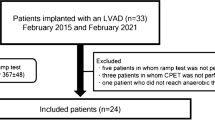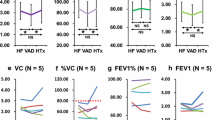Abstract
The hemodynamic and exercise capacity performance of the Jarvik 2000 left ventricular assist device (LVAD), which is generally used in patients with small body size and relatively preserved cardiac function, is not well understood. We retrospectively examined 18 patients implanted with the Jarvik 2000 LVAD. Pump rotation speed was optimized by the hemodynamic ramp test one year after implantation based on the criteria of mean pulmonary capillary wedge pressure (PCWP) < 18 mmHg, mean right atrial pressure (RAP) < 12 mmHg, and cardiac index (CI) > 2.2 L/min/m2 as well as echocardiographic parameters. Exercise capacity was assessed by cardiopulmonary exercise test in an optimized setting. To investigate the impacts of larger body surface area (BSA) and extremely impaired pre-implantation cardiac function on hemodynamics and exercise capacity, two correlation analyses based on BSA and original CI were performed. At a pump speed of 9500 ± 707 rpm, the mean pulmonary artery pressure, PCWP, RAP, and CI were 17 ± 5 mmHg, 9 ± 5 mmHg, 6 ± 4 mmHg, and 2.82 ± 0.54 L/min/m2, respectively. Only one patient failed to achieve the hemodynamic criteria. The peak VO2 and VE/VCO2 slope were 12.9 ± 3.1 mL/min/kg and 37.7 ± 15.0, respectively. There was an inverse correlation between original CI and heart rate (r = −0.60, p = 0.01), and a weak correlation between BSA and PCWP (r = 0.43, p = 0.08). Based on this study, the overall performance of the Jarvik 2000 device was acceptable, and the patients’ body size and original cardiac function had minimum effect on the performance of this device.




Similar content being viewed by others
References
Rose EA, Gelijns AC, Moskowitz AJ, Heitjan DF, Stevenson LW, Dembitsky W, Long JW, Ascheim DD, Tierney AR, Levitan RG, Watson JT, Meier P, Ronan NS, Shapiro PA, Lazar RM, Miller LW, Gupta L, Frazier OH, Desvigne-Nickens P, Oz MC, Poirier VL, Randomized Evaluation of Mechanical Assistance for the Treatment of Congestive Heart Failure (REMATCH) Study Group. Long-term use of a left ventricular assist device for end-stage heart failure. N Engl J Med. 2001;345:1435–43.
Estep JD, Starling RC, Horstmanshof DA, Milano CA, Selzman CH, Shah KB, Loebe M, Moazami N, Long JW, Stehlik J, Kasirajan V, Haas DC, O’Connell JB, Boyle AJ, Farrar DJ, Rogers JG, ROADMAP Study Investigators. Risk assessment and comparative effectiveness of left ventricular assist device and medical management in ambulatory heart failure patients: results from the ROADMAP study. J Am Coll Cardiol. 2015;66:1747–61.
Kirklin JK, Pagani FD, Kormos RL, Stevenson LW, Blume ED, Myers SL, Miller MA, Baldwin JT, Young JB, Naftel DC, Eighth Annual INTERMACS Report. Eighth annual INTERMACS report: special focus on framing the impact of adverse events. J Heart Lung Transplant. 2017;36:1080–6.
John R. Current axial-flow devices—the HeartMate II and Jarvik 2000 left ventricular assist devices. Semin Thorac Cardiovasc Surg. 2008;20:264–72.
Selzman CH, Koliopoulou A, Glotzbach JP, McKellar SH. Evolutionary improvements in the Jarvik 2000 left ventricular assist device. ASAIO J. 2018;64:827–30.
Tuzun E, Gregoric ID, Conger JL, Golden K, Jarvik R, Frazier OH, Kadipasaoglu KA. The effect of intermittent low speed mode upon aortic valve opening in calves supported with a Jarvik 2000 axial flow device. ASAIO J. 2005;51:139–43.
Siegenthaler MP, Martin J, Pernice K, Doenst T, Sorg S, Trummer G, Friesewinkel O, Beyersdorf F. The Jarvik 2000 is associated with less infections than the HeartMate left ventricular assist device. Eur J Cardio Thorac Surg. 2003;23:748–54.
Domae K, Toda K, Matsuura R, Miyagawa S, Yoshikawa Y, Hata H, Saito S, Yoshioka D, Sera F, Nakamoto K, Oshino S, Kishima H, Sakata Y, Sawa Y. Jarvik 2000 with postauricular cable as destination therapy: first clinical case in Japan. J Artif Organs. 2020;23:89–92.
Haj-Yahia S, Birks EJ, Rogers P, Bowles C, Hipkins M, George R, Amrani M, Petrou M, Pepper J, Dreyfus G, Khaghani A. Midterm experience with the Jarvik 2000 axial flow left ventricular assist device. J Thorac Cardiovasc Surg. 2007;134:199–203.
Kohno H, Matsumiya G, Sawa Y, Ono M, Saiki Y, Shiose A, Yamazaki K, Matsui Y, Niinami H, Matsuda H, Kitamura S, Nakatani T, Kyo S. The Jarvik 2000 left ventricular assist device as a bridge to transplantation: Japanese registry for mechanically assisted circulatory support. J Heart Lung Transplant. 2018;37:71–8.
Jung MH, Houston B, Russell SD, Gustafsson F. Pump speed modulations and sub-maximal exercise tolerance in left ventricular assist device recipients: a double-blind, randomized trial. J Heart Lung Transplant. 2017;36:36–41.
Uriel N, Sayer G, Addetia K, Fedson S, Kim GH, Rodgers D, Kruse E, Collins K, Adatya S, Sarswat N, Jorde UP, Juricek C, Ota T, Jeevanandam V, Burkhoff D, Lang RM. Hemodynamic ramp tests in patients with left ventricular assist devices. JACC Heart Fail. 2016;4:208–17.
Shah P, Badoe N, Phillips S, Abdullah K, May CW, Nabut JL, Singh R, deFilippi C, Desai SS. Unrecognized left heart failure in LVAD recipients: the role of routine invasive hemodynamic testing. ASAIO J. 2018;64:183–90.
Imamura T, Jeevanandam V, Kim G, Raikhelkar J, Sarswat N, Kalantari S, Smith B, Rodgers D, Besser S, Chung B, Nguyen A, Narang N, Ota T, Song T, Juricek C, Mehra M, Costanzo MR, Jorde UP, Burkhoff D, Sayer G, Uriel N. Optimal hemodynamics during left ventricular assist device support are associated with reduced readmission rates. Circ Heart Fail. 2019;12:e005094.
Feldman D, Pamboukian SV, Teuteberg JJ, Birks E, Lietz K, Moore SA, Morgan JA, Arabia F, Bauman ME, Buchholz HW, Deng M, Dickstein ML, El-Banayosy A, Elliot T, Goldstein DJ, Grady KL, Jones K, Hryniewicz K, John R, Kaan A, Kusne S, Loebe M, Massicotte MP, Moazami N, Mohacsi P, Mooney M, Nelson T, Pagani F, Perry W, Potapov EV, Eduardo Rame J, Russell SD, Sorensen EN, Sun B, Strueber M, Mangi AA, Petty MG, Rogers J, International Society for Heart and Lung Transplantation. The 2013 International Society for Heart and Lung Transplantation Guidelines for mechanical circulatory support: executive summary. J Heart Lung Transplant. 2013;32:157–87.
Imamura T, Kinugawa K, Ono M, Fukushima N, Shiose A, Matsui Y, Yamazaki K, Saiki Y, Matsumiya G, Arai H, Sawa Y. Bridge-to-bridge left ventricular assist device implantation strategy vs primary left ventricular assist device implantation strategy. Circ J. 2020;84:2198–204.
Frazier OH, Myers TJ, Westaby S, Gregoric ID. Use of the Jarvik 2000 left ventricular assist system as a bridge to heart transplantation or as destination therapy for patients with chronic heart failure. Ann Surg. 2003;237:631–6.
Apostolo A, Paolillo S, Contini M, Vignati C, Tarzia V, Campodonico J, Mapelli M, Massetti M, Bejko J, Righini F, Bottio T, Bonini N, Salvioni E, Gugliandolo P, Parati G, Lombardi C, Gerosa G, Salvi L, Alamanni F, Agostoni P. Comprehensive effects of left ventricular assist device speed changes on alveolar gas exchange, sleep ventilatory pattern, and exercise performance. J Heart Lung Transplant. 2018;37:1361–71.
Jung MH, Gustafsson F, Houston B, Russell SD. Ramp study hemodynamics, functional capacity, and outcome in heart failure patients with continuous-flow left ventricular assist devices. ASAIO J. 2016;62:442–6.
Jung MH, Gustafsson F. Exercise in heart failure patients supported with a left ventricular assist device. J Heart Lung Transplant. 2015;34:489–96.
Lee S, Katz JN, Jorde UP, Moazami N, John R, Sundareswaran KS, Farrar DJ, Frazier OH. Outcomes of adult patients with small body size supported with a continuous-flow left ventricular assist device. ASAIO J. 2016;62:646–51.
Zafar F, Villa CR, Morales DL, Blume ED, Rosenthal DN, Kirklin JK, Lorts A. Does small size matter with continuous flow devices? Analysis of the INTERMACS database of adults with BSA. JACC Heart Fail. 2017;5:123–31.
Ono M, Sawa Y, Nakatani T, Tominaga R, Matsui Y, Yamazaki K, Saiki Y, Niinami H, Matsumiya G, Arai H, Japanese HeartMate II Investigators. Japanese multicenter outcomes with the HeartMate II left ventricular assist device in patients with small body surface area. Circ J. 2016;80:1931–6.
Fitzpatrick JR 3rd, Frederick JR, Hsu VM, Kozin ED, O’Hara ML, Howell E, Dougherty D, McCormick RC, Laporte CA, Cohen JE, Southerland KW, Howard JL, Jessup ML, Morris RJ, Acker MA, Woo YJ. Risk score derived from pre-operative data analysis predicts the need for biventricular mechanical circulatory support. J Heart Lung Transplant. 2008;27:1286–92.
Nitta D, Kinugawa K, Imamura T, Amiya E, Hatano M, Kinoshita O, Nawata K, Ono M, Komuro I. A useful scoring system for predicting right ventricular assist device requirement among patients with a paracorporeal left ventricular assist device. Int Heart J. 2018;59:983–90.
Acknowledgements
We would like to thank Toshimitsu Koike and Yuhei Otsuka for technical assistance for CPET, and Editage (www.editage.jp) for English language editing. This work was supported by JSPS KAKENHI (grant number 19K17514).
Author information
Authors and Affiliations
Corresponding authors
Ethics declarations
Conflict of interest
Two authors (HK and GM) received research grant from Century Medical, Inc. All the other authors have no conflicts of interest to declare.
Additional information
Publisher's Note
Springer Nature remains neutral with regard to jurisdictional claims in published maps and institutional affiliations.
Rights and permissions
About this article
Cite this article
Iwahana, T., Kohno, H., Okada, S. et al. Performance of the Jarvik 2000 left ventricular assist device on mid-term hemodynamics and exercise capacity. J Artif Organs 25, 204–213 (2022). https://doi.org/10.1007/s10047-021-01302-3
Received:
Accepted:
Published:
Issue Date:
DOI: https://doi.org/10.1007/s10047-021-01302-3




